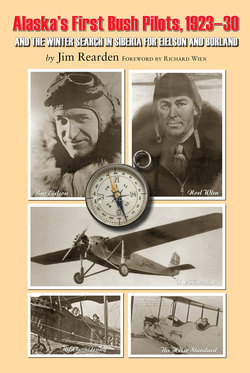Читать книгу Alaska's First Bush Pilots, 1923-30 - Jim Rearden - Страница 8
На сайте Литреса книга снята с продажи.
ОглавлениеForeword
In the early days of Alaska aviation, Fairbanks, being the geographic center of the Territory, became the natural service and supply point of the entire Interior, including the lower Yukon and Kuskokwim Rivers. Before the advent of the airplane, most commerce was handled by river travel in summer, and dog team in winter. When the first airplanes began replacing the river boats and dog teams, Fairbanks became the base of operations for the early pilots.
Starting around 1927, a major technological change developed in aviation, and it very much affected the dynamics in Alaska. It allowed my father, Noel Wien, in 1927 to initiate the first year-around regular air service between the two largest mainland Alaska communities, Fairbanks and Nome. This was made possible with the purchase of the Stinson Detroiter cabin biplane from arctic explorer Hubert Wilkins.
This Stinson was the first American-made cabin plane in Alaska. It moved the pilot out of the open cockpit that had long been in vogue, and which was impractical in Alaskan winters. Also, this airplane was powered by an air-cooled 220 hp Wright engine. The Wright was the first reliable engine that could function in the cold winters of Alaska’s Interior. This was the same engine that powered the Spirit of St. Louis across the Atlantic. Prior to the Wright, aircraft in Alaska and elsewhere used unreliable liquid-cooled engines, which were especially unsuitable for Alaskan winters.
A superb, modern, air-cooled engine that followed the Wright was the famous 420 Pratt and Whitney Wasp. My father often talked about his 1929 flight to North Cape, Siberia, with his new Hamilton Metalplane, the first airplane to fly in Alaska with the Wasp engine. It was an all-metal state-of-the-art, modern-for-its-time aircraft that he purchased in late 1928 for $26,000. That airplane, NC10002, played a major role in Alaska’s aviation history. It was an airplane he loved and flew for more than 450 hours before he sold it to Alaskan Airways, the company managed by Ben Eielson.
As my brother Merrill and I grew up, Noel often talked about the fur trader Olaf Swenson, who chartered our Dad’s Hamilton to make the first ever flight, North America to Asia, by flying to Siberia and the ice-locked trading ship Elisif. It held a cargo of valuable fur that needed to be flown to Fairbanks so it could be shipped via rail and sea to New York and London fur markets.
In recent years I discovered Swenson’s book (Northwest of the World, Dodd Mead & Company, 1944). I was thrilled to read about Swenson’s exploits, and his use of small ships to trade in Siberia, and the details of his being locked in ice at North Cape, Siberia. His story, too, is part of the Alaska-Siberian aviation epic.
I have also long been fascinated by the story of Ben Eielson, lost with his mechanic Earl Borland while attempting to fly the Hamilton my father had owned to Siberia and the iced-in Nanuk. It too held a cargo of valuable furs. The extensive midwinter search for the missing Hamilton and its two aviators was the most dramatic Alaska aviation epic of the period.
I have always been in awe of the flying of Joe Crosson and Harold Gillam in the winter of 1929-30 as they searched for the Hamilton. Having flown an open cockpit airplane, I cannot imagine flying in one as they did in temperatures of forty below zero, and with hardly any daylight. Gillam, who had just learned to fly, talked Crosson into letting him have an airplane to join the search. Other than the Hamilton and the Stinson Detroiter, there were no modern cabin aircraft in the Territory. At the time, the Stinson was damaged, leaving only open cockpit biplane aircraft available for the search. Fortunately, both search planes had Wright air-cooled engines.
Even today it would be difficult with a modern airplane with a heated cabin and radios to conduct a search under the arctic conditions these two pilots encountered.
My brother Merrill and I are often asked to make slide presentations about the early years of Alaska flying by our father and others. For these talks we have used many photos Noel took (many of which appear in this book). We both have vivid memories of his stories associated with these photos. In the process, we have frequently attempted to tell the story of the Siberian experience. It is a complex story, and it has been difficult to articulate the entire event during a brief evening presentation. We have both thought it important to have a book written that covered all aspects of the Eielson Siberian saga, including the background of early Alaska aviation and its pilots. It is a story that needed to be told in its entirety, which has finally become a reality with this volume.
I have known Jim Rearden for more than fifty years, and I have read many of his books. I helped him with his fine book Sam O. White, Alaskan, for Sam, an early-day flying game warden and bush pilot, was almost a second father to Merrill, me, and our sister Jean. It was then that Jim and I began to talk about the possibility of his writing about the Eielson/Borland saga. I gathered all of the information, books, and photos I had for him to study, and I was pleased when he agreed to tackle the project.
I have been impressed with Jim’s style of writing, and his ability to capture the essence of people and events. With this book, recounting the struggles of Alaska’s first bush pilots, he has done it again. I believe it will be one of the best of the many historical books on Alaska’s early aviation.
—RICHARD WIEN
